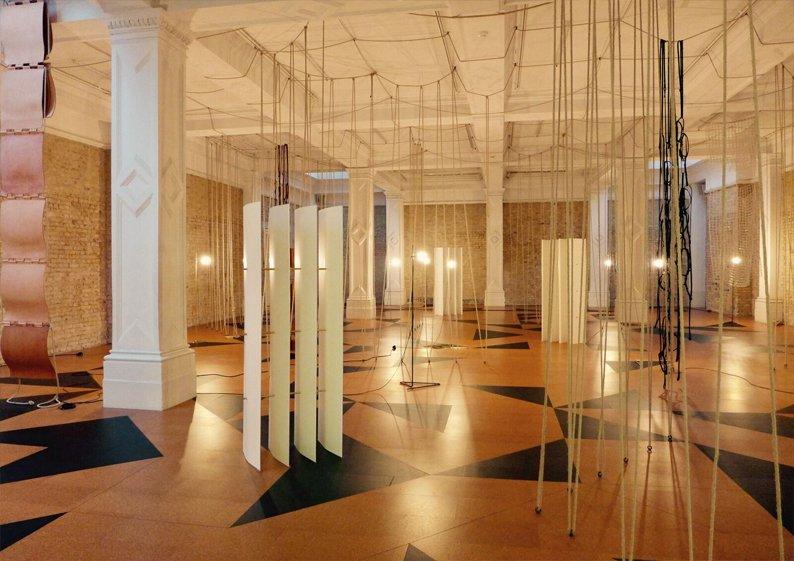


After the excesses of the holidays, Art and Architectural Historian Dr Anna Marazuela Kim finds moments of contemplation in two exhibitions - a new commission by Leonor Antunes at Whitechapel Gallery and Rachel Whiteread's retrospective at Tate Britain...
the frisson of the togetherness, Whitechapel Gallery
A soft, electric feeling charges Antunes' light-filled exhibition. Currents of connection slowly build as the viewer absorbs the elements of the room. A single rope weaves together the ceiling while cables tether it to the floor, choreographing the space in horizontal and vertical lines of flow. Repeating shapes serve as points on a map, directing possible itineraries across its compass-like base. The frisson of the togetherness a title drawn from British architect Alison Smithson, connects the work to an earlier history of the gallery, and also to women artists and designers with whom Antunes intentionally creates a dialogue, among them, Mary Martin, whose drawing informs the patterned floor, and the Brazilian artist Lucia Nogueira, whose jewellry is illumined in glowing spheres in an adjoining room.
Whether made of wood, hemp, leather or cork, there is an elemental materiality to the sculptures in the room. They retain their essential qualities beautifully, but minimally, worked and shaped. The result is a rich, synaesthetic experience of form, texture, color and smell that exceeds the traditional conventions of gallery display. The air carries the earthy musk of leather, emanating from looped horse bridles and cascading, tanned sheets. Undulating ropes make visible the potential of slack and tension inherent in woven fibres. Cork and linoleum yield their softness to the tread of one's foot. The room is a deep and layered archive of histories and practices of craft. More than artisanship on display, it is an experiential inquiry into the subject, into which the visitor is actively invited to participate.
Moving through the space, one is gently guided by various kinds of screens, which act less as barriers than signposts and points of interconnection. Woven nets refer to the fishing culture of the artist's native Portugal, but are also a reminder of the networks in which we are all potentially enmeshed. In her artist's talk at the gallery, Antunes described her practice as an art of relation: one consciously pursued in dialogue with history and with other artists, but also necessitating a migration, a moving away from home. The phenomenological experience of her work as it builds relationships among materials and practices, artists, spaces and audiences serves to activate forms of connection, the frisson of togetherness. As such, it speaks to larger philosophies of solidarity within the frame of the new materialism: the recognition that, in this rapidly shifting world of dynamic forces, we are all in it together.
Rachel Whiteread, Tate Britain
Monumental in scale, the Whiteread retrospective recalibrates the senses in a parallel, but different, way, powerfully forcing a renewed perception of shape, space and materials within its massive frame. Rather than a weaving together of elements, what we encounter are elements of architecture and home estranged from any familiar contexts of understanding. Inside is turned outside by Whiteread's signature process of casting, revealing the negative spaces that otherwise elude our consciousness. An enormous staircase rises to nothing but itself as a sculptural object of contemplation. The facades of doorways hang or prop against the wall, openings to nothing more than an appreciation of their exteriority. It is this profound sense of disorientation and disconnection that gives rise to a total aesthetic re-set, in addition to the severely limited palette of color and materials.
Sculptures of a smaller scale undergo a similar process of defamiliarisation. A series of hot water bottles cast in incongruous materials, such as plaster and polyurethane, prompt a renegotiation of their texture and form. Resin casts of the dark, underneaths of furniture and other household structures are transformed into glowing, light-filled presences.
Outside the entrance to the exhibition, a series of photographs and a film pay tribute to the artist's remarkable career, from the House (1993) of East London and the Turner Prize to the Judenplatz Holocaust Memorial in Vienna.
A series of display cases give insight into the mind of the artist, her design process, and the diverse, domestic objects of her inspiration. As it moves between the monumental and miniature, the material and abstract, the Whiteread exhibition offers not only an important retrospective of one of Britain's most significant women artists, but also a reflective, restorative, aesthetic detox from the excess of the holidays.
The frisson of the togetherness is showing at Whitechapel Gallery until 9 April 2018. The Rachel Whiteread retrospective is showing at Tate Britain until January 21.
Words by Dr Anna Marazuela Kim.




Add a comment